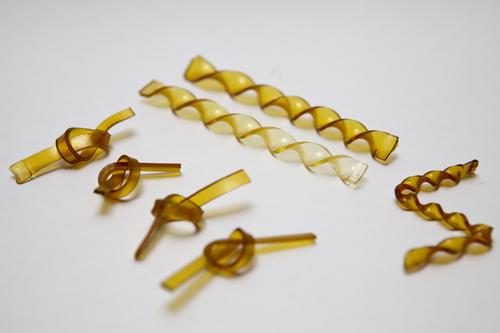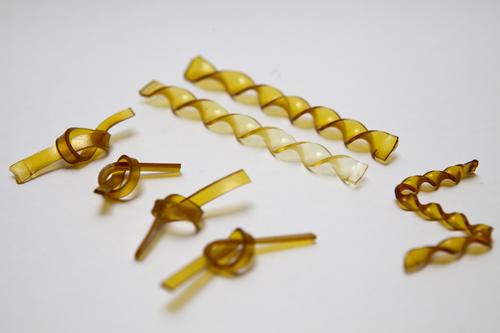Thermoplastic Resin Has Glass-Like Qualities
December 20, 2011

Unlike other organic resins used in composites for aircraft, automobiles, and electronic circuits, a new thermoplastic resin can be reshaped at high temperatures and is recyclable.
The material, developed by a research team at France's Laboratoire Matiere Molle et Chimie, retains the strength, chemical and thermal resistance, and lightweight characteristics of typical thermosetting resins. The main difference is its thermoplastic nature, which makes it behave more like glass.
Once cured and hardened, typical thermosetting resins cannot change their shape, even when heated or by using solvents. This makes their repair and recycling difficult or impossible. Unlike these materials, glass gradually changes from a solid to a liquid when heated, as do thermoplastics. This allows glass or thermoplastics to be shaped as needed without requiring molds. Glass, of course, based on silica, is brittle and relatively heavy compared to thermosetting resins. Thermoplastics tend to have considerably less strength, dimensional stability, and chemical or thermal resistance than thermosetting resins.

Combining the best characteristics of both material types, thermoplastics and thermosetting resins, was highly unlikely. But the research team, headed by the laboratory's director, Ludwik Leibler, has developed an entirely new organic material that does exactly that. It consists of a molecular network with original properties. When heated, the network reorganizes itself without changing the number of cross-links between its atoms. In the same way as glass, the material can change from a solid to a liquid state and back again. It is insoluble even when heated above its glass transition temperature.
Before this research, the only materials with these characteristics were silica and some inorganic compounds. The team used existing materials, such as epoxy resins, hardeners, and catalyst typically used in industry, as a basis for developing the new material.
Since the composites used in several industries are based on thermosetting resins, the new material could potentially revolutionize these composite manufacturing processes and, in turn, the manufacturing processes of automobiles, aircraft, and electronics. Like the thermosetting resins, the new material is inexpensive and easy to produce.
About the Author(s)
You May Also Like
.jpg?width=300&auto=webp&quality=80&disable=upscale)


